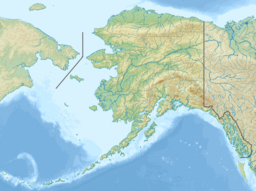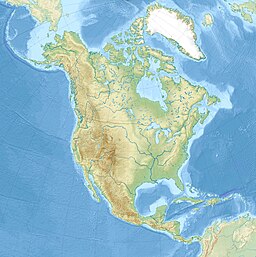geo.wikisort.org - Reservoir
Teshekpuk Lake (Iñupiaq: Tasiqpak) is a 22 miles (35 km) wide lake on the Arctic coast of the U.S. state of Alaska, South of Pitt Point, 12 miles (19 km) east of Harrison Bay, 80 miles (130 km) east of Point Barrow.[1]
| Teshekpuk Lake | |
|---|---|
 False-color image of Teshekpuk Lake (on left side of image) and the North Slope. Green indicates vegetation and blue indicates water. Some bodies of water also appear in off-white or yellowish, probably due to different amounts of sediment in the water and/or the sun angle. The Beaufort Sea is at the top of the scene. | |
| Location | North Slope Borough, Alaska |
| Coordinates | [1] |
| Native name | Tasiqpak (Inupiaq) |
| Basin countries | United States |
| Max. width | 22 mi (35 km)[1] |
| Surface area | 320 square miles (830 km2)[2] |
| Surface elevation | 7 ft (2.1 m)[1] |
| References | [1] |
Etymology
Its name comes from the Iñupiaq language Tasiqpak, recorded by Rochfort Maguire as Tasok-poh in 1854, and reported to mean "big lagoon", "big enclosed coastal water" or "big coastal lake".[1][3]
Also known as:[1]
- Lake Teshekpuk
- Tasekpuk Lake
- Tasirkpuk Lake
- Tasyukpun
- Tasiqpak
Environment

Teshekpuk Lake is the largest lake in Arctic Alaska, the largest thermokarst lake in the world. Fish species in the lake include broad whitefish (Coregonus nasus), Arctic grayling (Thymallus arcticus), Burbot (Lota lota), Arctic cisco (Coregonus autumnalis), lake trout (Salvelinus namaycush), Dolly Varden (Salvelinus malma), Chinook salmon (Oncorhynchus tshawytscha) and chum salmon (Oncorhynchus keta).[4] The region provides habitat to a variety of arctic wildlife, including the Teshekpuk Lake Caribou Herd (64,000 animals), and large numbers of shorebirds and migratory waterfowl. The Teshekpuk Lake Observatory was established by the U.S. Geological Survey, National Science Foundation and other partners to study impacts of climate change on the arctic environment.[5]
In July 2007, a study reported that the disappearance of sea ice near Teshekpuk Lake is causing rapid erosion in the marshy, wildlife-rich area. In some places, the sea has pushed in half a mile and salt water has contaminated freshwater lakes. According to the study, migratory birds, caribou and other wildlife populations have lost habitat, and the sparse human infrastructure along the coastline has been damaged. According to Stan Senner, executive director of Audubon Alaska, "The area (Teshekpuk Lake) is one of the most important areas in the entire Arctic, and I don't just mean in Arctic Alaska...It is simply the most important goose-molting area in the Arctic."[6]
Drilling controversy
On January 11, 2006, the U.S. Department of the Interior (DOI) approved oil and gas drilling on approximately 500,000 acres (2,000 km2) of land in and around Teshekpuk Lake on Alaska's North Slope within the National Petroleum Reserve-Alaska. Up to 90,000 geese congregate in this area in summer to undergo wing molt, and up to 46,000 caribou use the area for both calving and migration. Some environmental groups contested the DOI decision to allow drilling. The decision stipulated that no surface drilling would be allowed on land considered crucial for molting geese or caribou, and a maximum of 2,100 acres (8.5 km2) in seven different zones could be permanently disturbed on the surface.
On September 25, 2006, the U.S. District Court for the District of Alaska issued a decision that removed the wildlife habitat around Teshekpuk Lake from an oil and gas lease sale that was held on September 27. The court found that the U.S. government's environmental analysis had violated federal environmental laws. The ruling struck down the Interior Department's leasing plan for the area, prohibiting the Bureau of Land Management (BLM) from leasing more than 400,000 acres (1,600 km2) around the lake. Prior to the decision, led by a coalition of environmental organizations and Alaskan Natives, U.S. citizens sent over 300,000 comments to the Secretary of Interior and the CEO of ConocoPhillips.
Environmentalists and the region's Iñupiat have also cited the impacts of global climate change as a reason to oppose drilling in land near Teshekpuk Lake.[6]
See also
Notes
- "Teshekpuk Lake". Geographic Names Information System. United States Geological Survey, United States Department of the Interior. Retrieved 2009-05-04.
- "Teshekpuk Lake | lake, Alaska, United States".
- "Cold Regions Lake and Landscape Research: Teshekpuk Lake Observatory." USGS Alaska Science Center. Accessed 7 Feb 2014.
- http://www.adfg.alaska.gov/static/lands/habitatresearch/pdfs/tesh_fish_2003_2005.pdf [bare URL PDF]
- "TESHEKPUK LAKE OBSERVATORY - Teshekpuk Lake Observatory".
- Erosion Slicing Arctic Alaska Habitat Archived 2007-07-11 at the Wayback Machine
References
External links
- NASA: Teshekpuk Lake, Alaska's North Slope
- Audubon Alaska: Teshekpuk Lake
- Teshekpuk Lake: Arctic Nursery Video
- Teshekpuk Lake Observatory Live Camera with archiving[permanent dead link]
На других языках
- [en] Teshekpuk Lake
[fr] Lac Teshekpuk
Le lac Teshekpuk est un lac de 35 kilomètres de long, situé à sur la côté arctique de l'Alaska aux États-Unis. Il se trouve au sud de Pitt Point, à 19 kilomètres à l'est de Harrison Bay et 130 kilomètres à l'est de Point Barrow[1].[ru] Тешекпук
Тешекпук (англ. Teshekpuk Lake) — пресноводное озеро на крайнем севере штата Аляска, США. Расположено вблизи побережья Северного Ледовитого океана, к югу от мыса Питт-Пойнт и примерно в 130 километрах к востоку от мыса Барроу[1]. В административном отношении озеро находится на территории боро Норт-Слоп. Площадь водного зеркала — 430 км²[2].Другой контент может иметь иную лицензию. Перед использованием материалов сайта WikiSort.org внимательно изучите правила лицензирования конкретных элементов наполнения сайта.
WikiSort.org - проект по пересортировке и дополнению контента Википедии

